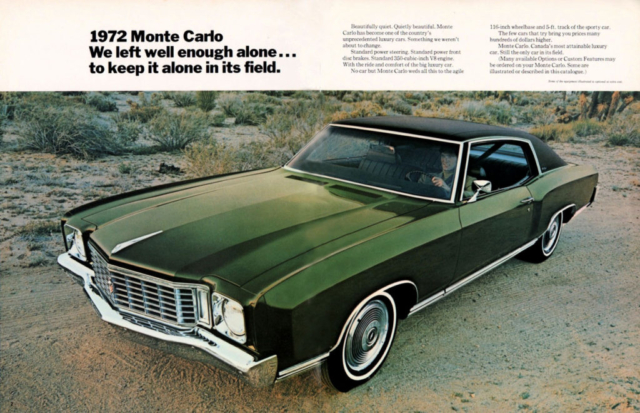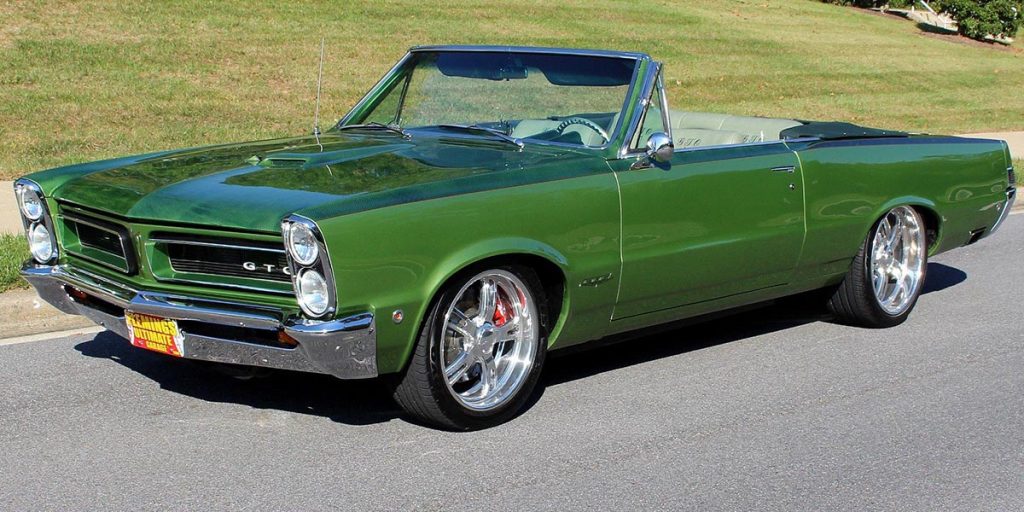
The 1972 Monte Carlo remained largely unchanged from the previous model year, it did however receive many minor styling revisions that refined the look and feel of the final year of the first generation.
The available powertrain options from 1971 were retained, however, the slightly revised horsepower ratings were now only provided in SAE net values as per the new mandate. The previous year saw both net and gross values given as part of the transition to the new industry wide SAE net standard.
The most notable change to the lineup was the loss of the SS 454 package. The 454 CID engine was still an available powerplant, but the ’72 Monte Carlo embraced its role as a personal luxury coupe which would downplay the emphasis on sports, partially due to a lack of strong sales for the package. While the Turbo-Jet 454 big block was retained as an optional engine, the 4 speed manual transmission sadly was not a part of this refocusing, sales were also not particularly strong for four speed equipped Monte Carlos.
The rest of the powertrain choices were essentially unchanged from 1971, but the horsepower ratings were slightly revised to be more accurate for the Turbo-Jet 402 and 454 engine options. In 1971 the 402 and 454 were advertised as having 260 and 285 horsepower but were now advertised as only making 240 and 270 horsepower respectively for 1972. The Turbo-Jet 454 was also the only engine that would retain engine size and horsepower air cleaner decals for the 1972 Monte Carlo. Lastly, the two versions of the Turbo-Fire 350 small block did not receive any changes to their power ratings.
Cars destined for sale in the state of California would once again receive the 350 small block with a 4 barrel carburetor as the only available engine option due to the tighter emissions standards. Likewise, the only transmission option in California was the three speed Turbo-HydraMatic 350 automatic for many of the same reasons.
Interior revisions were minimal for 1972. A new Custom steering wheel was offered and the dash control knobs and cigarette lighter received a slight redesign once again. Other changes from 1971 would be carried over.
Variable ratio power steering was now standard equipment being offered for 1972. The interior treatment was much the same as the previous year, with the most significant new option being that vinyl upholstery was now available with the standard bench seat as well as the optional Strato-bucket seats as it was in 1971. Cloth interior was still offered for all trim levels.
The subtle exterior revisions that were incorporated into the 1972 update were mostly alterations of existing elements.
For example, 1972 integrated the parking lamps into the grille, which also became wider than in 1971 and featured a different egg crate grid pattern. The thin hood spear of the past two years was also widened and slightly changed in appearance. No longer was there a pop-up “Chevrolet” ornament, instead a script that reads “MC” was integrated in its place. The emblems also received slight changes in ’72, with the grille and trunk emblems no longer including the Roman numerals that had been featured previously.
New for 1972 was the Monte Carlo Custom option that would take the place of the SS package for this one year only option. It could be ordered with any of the available powertrain choices and was not tied to any specific combination of engine and transmission, unlike the SS 454 option it replaced. It was targeted as an appearance and convenience package rather than a direct replacement for the SS 454, but it did include many of the options that were included with the SS 454 package. This trend was becoming common across GM’s lineup due to the looming Oil Crisis and tightening emissions regulations.
The list of available options for the Z03 Monte Carlo Custom entailed:
- D35 Left-Hand Remote mirror
- B85 Belt molding
- P02 15” x 7” Custom Spoke wheel covers (Corvette style)
- NK2 Custom Steering wheel with “Chevrolet” script
- C01 Sail Panel Emblem
- ZJ9 Auxiliary Lighting (ashtray, floor, mirror, luggage, under hood)
- ZK1 Body Insulation Package
- F41 Front and Rear Sport Suspension
- G70x15 Tires
- Special Acoustical Package
The Z03 Custom package was also rather popular as the option could be ordered with any powertrain combination. Unfortunately, there was no way to identify just how many were sold as it wasn’t a special “model”, and this information would not be found in the VIN. The Z03 RPO can be found on the build sheet as usual, and also on the cowl tag for Canadian-built Montes. The only identifying callouts were the “Custom” emblems that were located on the exterior of the sail panels.
Subtle changes were the norm for 1972 as the following year would be the start of the second generation design.
The final year of the first-generation Monte Carlo would close out strongly, with sales of the Monte Carlo the best they had been yet for 1972, with a total of 180,891 units moved for the model year. This number was up well above the 112,599 units sold during 1971, largely due to the labor strike that shuttered production for two months, and also much higher than the initial 145,975 units sold for the model’s debut for 1970. It appeared that Chevrolet had a hit on its hands in the new personal luxury car segment.
The Monte Carlo would continue to compete with the Pontiac Grand Prix and the Ford Thunderbird as its main adversaries in the market segment that it helped popularize. The Monte Carlo’s advantage was that it was priced slightly lower than both the Grand Prix, Thunderbird, Cadillac El Dorado, and even other up and coming personal luxury coupes that the Monte competed against, though Chevrolet would advertise the Monte Carlo was in a league of its own due to its unique price point.
The 1972 Monte Carlo would continue to excel in motorsport as well. Perhaps the most iconic example of this model year in motorsports is Bobby Allison’s 1972 Monte Carlo. Bobby would go on to earn multiple victories during the 1972 NASCAR Winston Cup Series using his ’72 Monte, winning 10 of the 31 races held in the series that year. Since this was still the era of NASCAR where they were using real cars that could be purchased, it was a boon for Chevrolet to have such success with the Monte Carlo’s performance.
1972 Monte Carlo OEM Brochure & Ads
Model Options
Models:
- Monte Carlo
- Monte Carlo Custom
Body Style:
- Two-door hardtop
Dimensions:
- Length: 206.5 inches
- Height: 52.9 inches
- Width: 76 inches
- Wheelbase: 116 inches
Engine Options:
- 350 cubic in “Turbo-Fire” small-block V8 (standard)
- two-barrel carb
- 165 hp at 4000 rpm
- 350 cubic in “Turbo-Fire” small-block V8 (optional)
- four-barrel carb
- 175 hp at 4000 rpm
- 402 cubic in “Turbo-Jet” big-block V8 (optional)
- four-barrel carb
- 240 hp at 4400 rpm
- 454 cubic in “Turbo-Jet” big-block V8 (optional)
- four-barrel carb
- 270 hp at 4000 rpm
Available Transmissions:
- 3-speed Synchro-Mesh manual transmission (standard)
- Two-speed Powerglide automatic transmission (optional)
- Three-speed Turbo-Hydramatic (optional)
Estimated Production Numbers:
- Sport Coupe: ~ 180,819
- Total Production ~ 180,819
1970 Monte Carlo Factory Options
Available Engine Specifications
Available Rear Axle Codes
1972 Monte Carlo Factory Options
Regular Production Option (RPO)
Available Color Codes
Available Two-tone Color Codes









